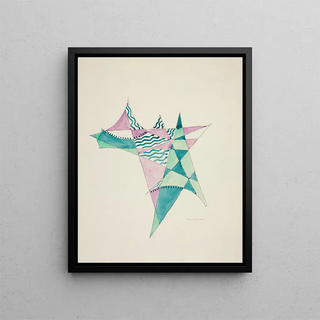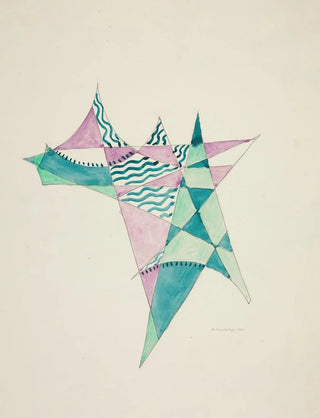Art print | Abstraction based on Sails VIII - David Kakabadze


View from behind

Frame (optional)
Art print Abstraction based on Sails VIII - David Kakabadze – Captivating Introduction
In the vast panorama of abstract art, the piece "Abstraction based on Sails VIII" by David Kakabadze stands out for its boldness and conceptual depth. This work, at the crossroads between figurative and abstract, invites the viewer to immerse themselves in a universe where form and color intertwine to create a striking visual experience. Kakabadze, an emblematic figure of 20th-century Georgian art, manages to capture the essence of modernity while paying homage to traditional elements, notably through the theme of sails that evoke both travel and the quest for identity.
Style and uniqueness of the work
"Abstraction based on Sails VIII" is characterized by a vibrant color palette and dynamic shapes that seem to dance across the canvas. The sinuous lines and organic motifs evoke the movement of sails in the wind, while allowing for a personal interpretation by each observer. The piece plays with conventions, blending abstraction and figurative suggestions, making it both accessible and mysterious. Kakabadze employs techniques that demonstrate his mastery of materials, creating layers of texture that add a tactile dimension to the vision. Each brushstroke appears charged with meaning, inviting prolonged contemplation. Thus, the viewer is encouraged to explore not only the surface of the work but also the emotions and reflections it evokes.
The artist and his influence
David Kakabadze, born in 1889 in Georgia, is often regarded as a pioneer of modern art in his country. His career was marked by an incessant search for new forms of expression, influenced by European artistic movements such as cubism and fauvism. Kakabadze is also recognized for his ability to fuse elements of Georgian culture with modern techniques, creating a work that resonates both locally and universally. His commitment to art as a means of political and social expression has also left an indelible mark on subsequent generations of artists. Through "Abstraction based on Sails VIII," he manages to

Matte finish

View from behind

Frame (optional)
Art print Abstraction based on Sails VIII - David Kakabadze – Captivating Introduction
In the vast panorama of abstract art, the piece "Abstraction based on Sails VIII" by David Kakabadze stands out for its boldness and conceptual depth. This work, at the crossroads between figurative and abstract, invites the viewer to immerse themselves in a universe where form and color intertwine to create a striking visual experience. Kakabadze, an emblematic figure of 20th-century Georgian art, manages to capture the essence of modernity while paying homage to traditional elements, notably through the theme of sails that evoke both travel and the quest for identity.
Style and uniqueness of the work
"Abstraction based on Sails VIII" is characterized by a vibrant color palette and dynamic shapes that seem to dance across the canvas. The sinuous lines and organic motifs evoke the movement of sails in the wind, while allowing for a personal interpretation by each observer. The piece plays with conventions, blending abstraction and figurative suggestions, making it both accessible and mysterious. Kakabadze employs techniques that demonstrate his mastery of materials, creating layers of texture that add a tactile dimension to the vision. Each brushstroke appears charged with meaning, inviting prolonged contemplation. Thus, the viewer is encouraged to explore not only the surface of the work but also the emotions and reflections it evokes.
The artist and his influence
David Kakabadze, born in 1889 in Georgia, is often regarded as a pioneer of modern art in his country. His career was marked by an incessant search for new forms of expression, influenced by European artistic movements such as cubism and fauvism. Kakabadze is also recognized for his ability to fuse elements of Georgian culture with modern techniques, creating a work that resonates both locally and universally. His commitment to art as a means of political and social expression has also left an indelible mark on subsequent generations of artists. Through "Abstraction based on Sails VIII," he manages to






